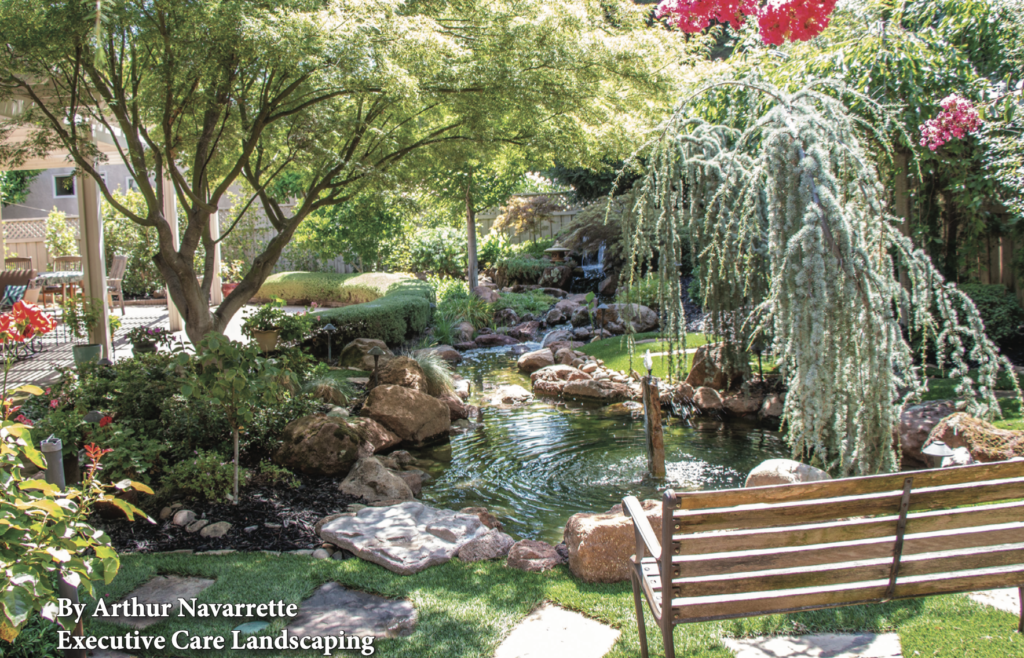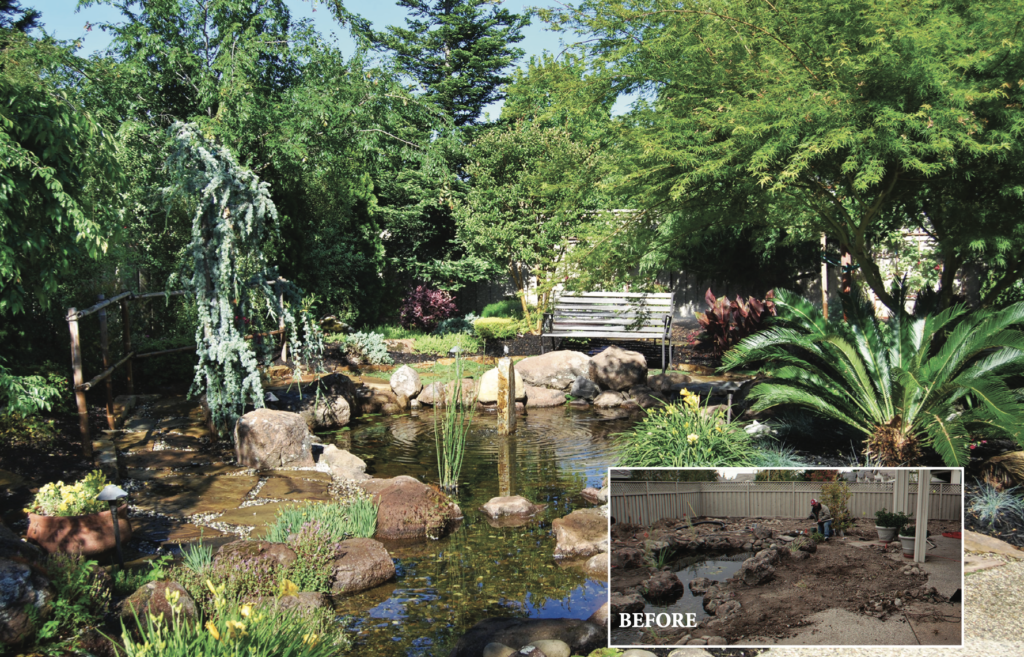Welcome to our August issue. Last month’s article featured a video, I hope you took advantage of watching it. It was a treat for me to show you the landscape in “real time.” This month the article will again include a video. It should be a huge treat. Technology brings some cool things to the table. For me to be able to film and share my comments of the landscape as I am shooting the footage is super cool. Pictures are still very necessary to capture a specific angle, but they are limited. They do not show the full scope of the job, and do not give the feeling of being there. The sound of the water in this video makes you want to take your shoes off and relax. I will continue to film our landscapes, especially our mature ones.

This landscape was completed fifteen years ago in March of 2005. I am so pleased with how it has matured, and with how my client Diane has maintained it. Maintaining the landscape is important. We can install a beautiful landscape, but if it is not properly maintained, it will not develop well. We help with this by offering quarterly maintenance, as well as email updates that include watering instructions. This helps take the guess work out of proper watering, which is the single most important thing in regards to maintenance. We seek to make caring for your landscape enjoyable and non-stressful. We do the hard stuff such as checking drip irrigation yearly and upsizing the emitters after two or three years of growth. We also apply preemergent for weeds, fertilizer for growth and do pruning as needed. Basically, we service everything we install, from drip irrigation to low voltage lighting and everything in between. These are the ways we seek to help our customers.
Diane had just retired from AT&T and moved to Sun City when she called us. She wanted her yard to be her oasis. I had a friend help me with the waterfall/pond because that was his specialty. We supplied the labor. I think the waterfall and pond add a very tranquil influence to the yard. Be mindful that there is maintenance with waterfall/ponds as well. Once the water feature was installed, my friend left, and I turned my attention to putting the backyard back together (it got torn up installing the pond). I also started prepping for the landscape. We used 24” box trees for a more mature look, and upon completing the landscape, we built our first ever mist system under her patio. It was fairly simple because it was much like a drip system. Instead of drip tubing, we used PVC, and instead of emitters, we installed misters. From start to finish the whole job took 5 weeks.
This landscape has many faces to it. In the early spring, the Weeping Cherry and Star Magnolia come into bloom. Their white blooms, along with the Azaleas, are beautiful. In the summer, the shade from the Redwoods and Cedar are nice, and the accent that the Atlas Cedar brings definitely emphasizes the Asian/Northern California theme. In the fall, the Acer Sieryu is in fall color. If you google fall color Acer Sieryu, you will see it is one of the most beautiful trees for fall color period. In the winter, we have the Camellias in bloom so regardless of the season, there is always something to appreciate, and coupled with the sound of the water, there is never not a time for one to come out and enjoy the yard.

We also did Diane’s front yard. We took video of this as well. The front has a beautiful Atlas Cedar, as well as some other specialty plants. The Birch is one of my favorite trees with its beautiful white bark, but it does not like the heat. There is only one variety that I like, which is the Heritage Birch. This variety does not have all the pitfalls of other varieties, but like all Birch, the Spring seed pods make it messy. If you enjoy the Birch as well, just make sure to plant it away from a pool or else the seeds pods will get blown into it, and be an issue for your pool filter. There are two more interesting plants. Harry Lauder’s Walking Stick is to the right of the front door. It is an interesting plant, especially in the winter. Without leaves, its crookedness becomes its charm, and it is more crooked than any other plant (google it). It is an amazing plant! The other plant is Juniper Green Mound which was trained upright. Its normal growth pattern is as a ground cover, so this is an interesting use of a ground cover. The next thing that is most beautiful, especially since it blooms in early spring when it and the Birch have no leaves, is the Tulip Magnolia (Magnolia soul purpurea). With its large purplish blooms, and its size it is simply stunning.
Overall, there is nothing I would have done differently. Everything was planted for a reason and I still agree with my choices. Honestly, after fifteen years of experience, it is nice to know that I gave Diane, as well as all of my other clients since then, my best shot. My experience with growing plants in the wholesale nursery field prior to landscaping has really paid off. The only changes I have really dealt with as a landscaper are new plant varieties not growing as described. I like to try different plants so I can learn and expand the selection of plants that we can offer our clients. There have been some new varieties that we have had to replace because they did not perform as stated. This was especially true several years ago with a plant named Guara. Guara is a beautiful free-growing plant friendly to butterflies, and it was supposed to not exceed 18” inches. After six months of being in the ground, it grew 3’ft. by 3’ft. That is a huge difference from 18”! Though I love the gracefulness and butterfly friendly look of Gaura, I did not love its uncontrolled growth. We replaced numerous plants at our cost, which I think is only fair to do.
Gardeners, we are entering the home stretch for our summer gardens. It is time for another application of fertilizer to keep them producing into mid-September. By then, I like to pull the vegetables and leave the ground fallow for a couple weeks. This gives the microbiology a break before introducing the fall/winter plants in October. For now, watch for tomato worms. I always see them in early August. They can do some serious damage if they go undetected for several days, look for stems with no leaves. Until next time – Good gardening.
